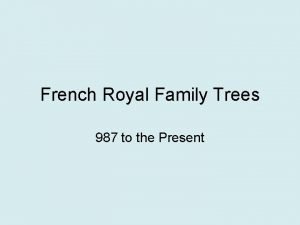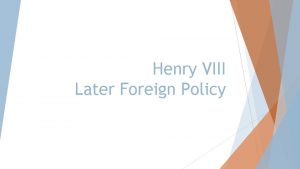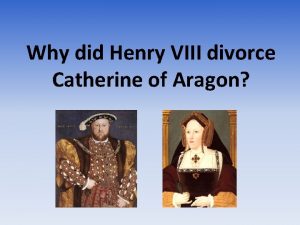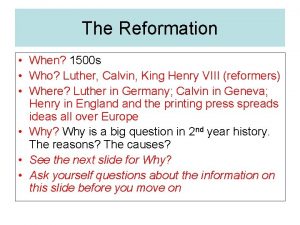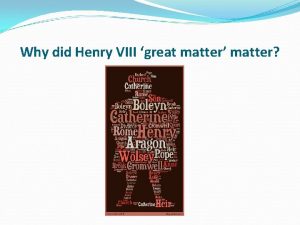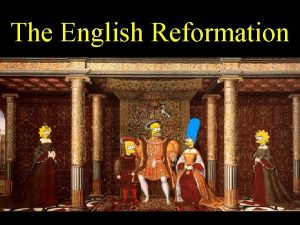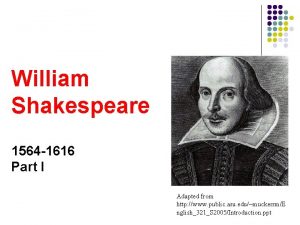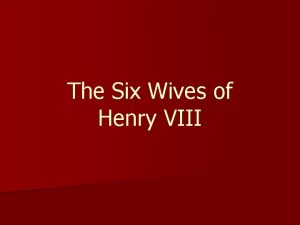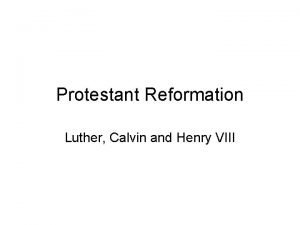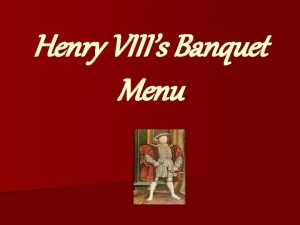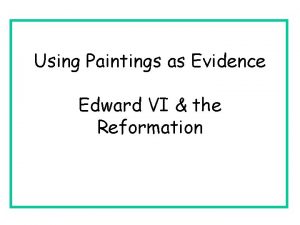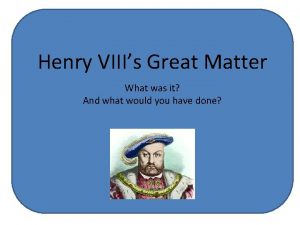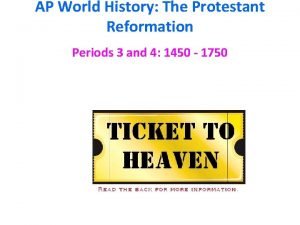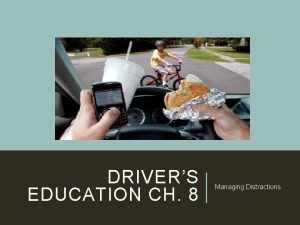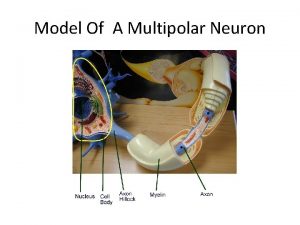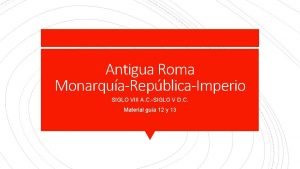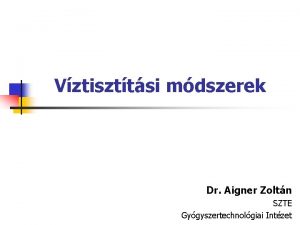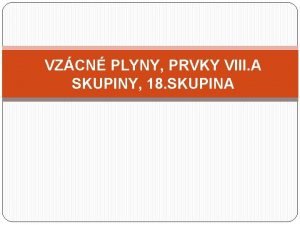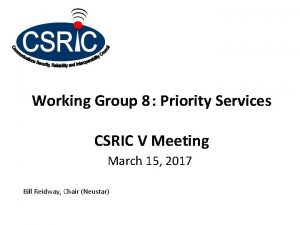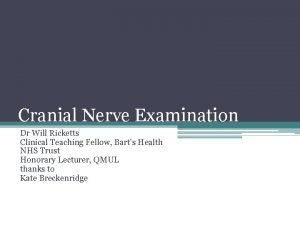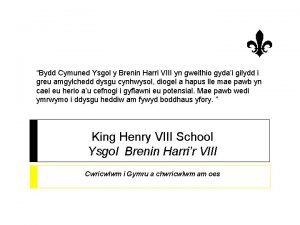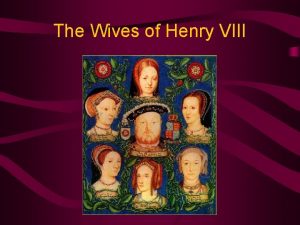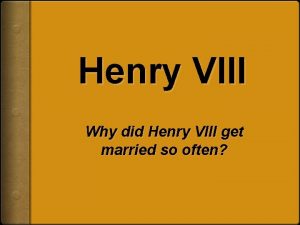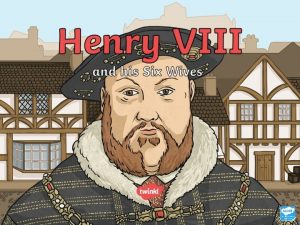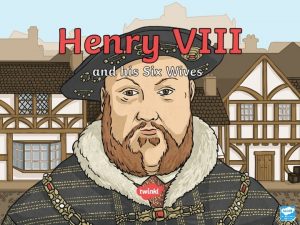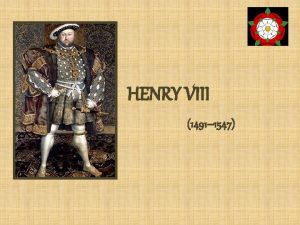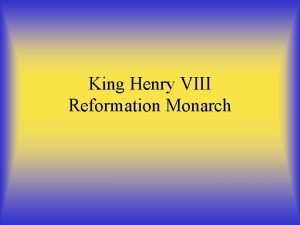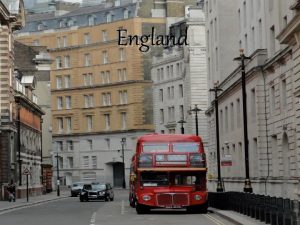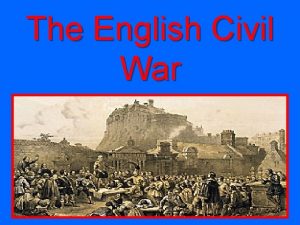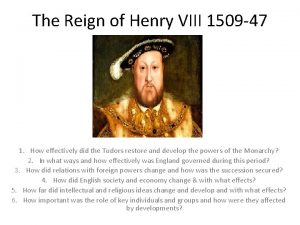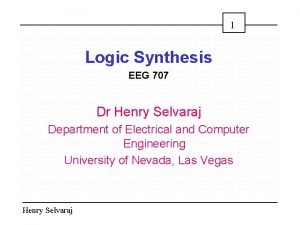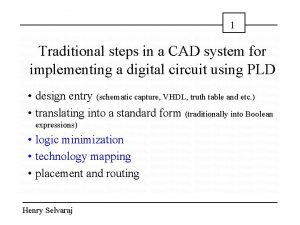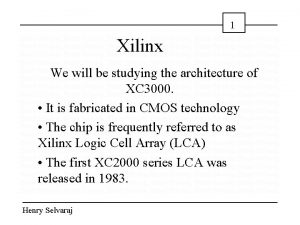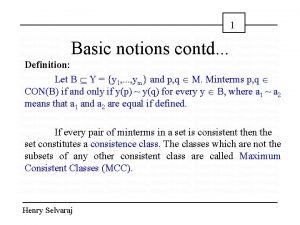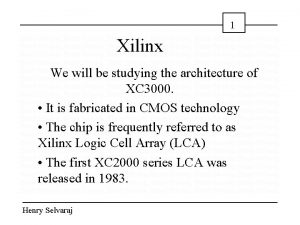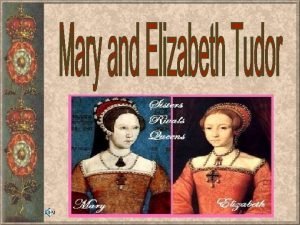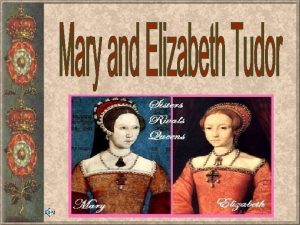Henry VIII Revision 2018 Henry VIIIs Reign Factions






























- Slides: 30

Henry VIII Revision 2018

Henry VIII’s Reign Factions 1547 Cromwell 1540 1532 More 1529 1515 1509 Wolsey

Key Individuals Foreign Relations and Successio n Society and Economy Power of the Monarchy Government Religion

Government: Overview • 1509 -1515: Council Learned in Law; Court, Nobility, Style of Government • 1515 -1529: Wolsey (legal, economics, finance reform; Parliament; divorce) • 1529 -1532: More (divorce) • 1532 -1540: Cromwell (Revolution in Government debate) • 1540 -1547: Factions and what this means for Henry’s power

Government: 1509 -1515 • Within days of his accession, HVIII ordered the arrest of Empson and Dudley • Henry abolished the unpopular Council Learned in the Law • Henry’s Court is dedicated to pleasure and refinement. But, he also enjoyed the company of scholars steeped in the new learning of the Renaissance. • Henry’s attitude towards the nobility was different to that of his father. Early gestures of good will include cancelling 175 bonds. There is no doubt that Henry regarded the nobility as his friends and associates. • Henry shared his suspicion o possible rivals amongst the nobility. In 1513, Henry had Edmund de la Pole executed for treason. • Henry’s style of government was personal. He took major decisions himself, without the aid of a Chief Minister. • Henry continued to use Justices of the Peace rather than relying on nobles in the localities.

Government: 1515 -1529 • • • Legal Reforms Aim was to tackle slowness and unfairness Promoted civil law (evidence) over common law Strengthened Star Chamber (12 120 cases) Reputation as a ‘friend to the poor’ Now met at Financial Whitehall Reforms Shortage of money was a problem for HVIII National survey (1522): into who could pay tax (first of its type since Doomsday Book), gained £ 200, 000. Subsidy (1523): based on income not property, did not raise as much as hoped. 1525 Amicable Grant: tax for church/ordinary payers based on their property value. Provoked rebellion. • • Economic Reforms No coherent economic policy 1517 – national enquiry into enclosure Then, legal cases were drawn up against landlords who had enclosed without proper permission 1523 -26 suspended cases due to opposition from landlords in Parliament Wolsey could be accused of trying to rule without Parliament (called Parliament twice) 1515: Hunne’s Case – Bishop Scandal p. 53 1523: Agree to taxation as a result of foreign policy

Government: 1515 -1529 Scriptural argument Diplomatic manoeuvr es Legal Efforts Wolsey used Leviticus 20: 16 to suggest that there was no proof that Catherine and Arthur’s marriage had not been consummated. Henry was convincined the his lack of a male heir was God punishing him. However, theologians disagree on this biblical extract. Some said that it only counted is Arthur was alive, and because he was dead, Henry actually had a duty to marry Catherine. Charles V was unlikely to support the divorce and Charles was in control of Italy, holding the Pope hostage… Wolsey tried to free the Pope by using an alliance with France and the renewal of warfare in Italy to distract Charles. However, Charles was too entrenched in the Italian peninsula to be evidenced from France. Wolsey decided to hold the divorce hearings in England (as Papal Legate he could then make the call). Pope Clement VII sent Campeggio to England with strict instructions to delay the hearing and ensure no decision was reached. Campreggio genuinely took months to arrive. When the court final met in 1529, Catherin refused to recognise it and appealed to the Pope to move the hearing to Rome. The Pope agreed. At this point Wolsey had run out of options…

Government: 1529 -1532 • Thomas More was a able scholar, but poor replacement as Lord Chancellor. • More had a reputation for putting his principles before anything else. • He held strong Humanist beliefs (wrote Utopia in 1516). • He had also written a book called Richard III which helped foster the myth that they Yorkist king was a evil, murdering monster. • More was deeply sympathetic to Catherine of Aragon • Whilst he criticised the Catholic church, he was convinced that reform could be achieved • 1529 -32 Henry applied measures designed to pressure the clergy into supporting his divorce • FINISH OFF

Government: 1532 -1540

Was a Revolution in Government Power of the Monarchy Financ e Council • • • ment • • • Royal Council (large group - nobles, clergy and King’s household) transformed into the Privy Council. This was a much smaller group of around 20 members. Privy Council contained mainly trained lawyers and administrators, rather than the traditional noble families. Cromwell created new financial institutions, including: • -Court of: Augmentations, First Fruits and Tenths, Wards Was not a Revolution in Government • • • Power increased (Act of Supremacy and Cromwell wrote that • everyone owed the King (who was chosen by God) total obedience. The Act of Union with Wales (1536) reorganised local government in Wales and the Marches, giving the monarch greater control. An Act against Liberties and Franchises restricted the special powers of regional nobles, such as the Prince Bishop of Durham. Began to play a central role - Henry needed it to agree to the various Acts. It met for an unbroken period (1529 -1536) By the end of this period, statute law (law made by Parliament with the King’s consent) represented ultimate authority in England. • • Arguably Wolsey’s idea, as early as 1526 - and not Cromwell’s. Other historians argue that these changes did not really begin until after Cromwell’s death in 1540. Cromwell continued HVIII’s approach (managing finances from the Privy Chamber. ) Henry VII = Master of the King’s Wards. The power of the monarch was immense even before Cromwell’s changes. These powers included significant influence over appointments to church positions and emergency taxation. Parliament could not call or prorogue itself. When parliament was not sitting the King could still govern by Proclamation. 1540 s - King did not call Parliament frequently The increase in the power of Parliament was

Factions: 1540 -7 • • CONSERVATIVE FACTION (1540 -1546) Accept the break with Rome but oppose doctrinal change Key members: Duke of Norfolk, Stephen Gardiner Success: Six Articles of Religion; fall of Cromwell; marriage to Catherine Howard Failures: Catherine Howard was beheaded, Plot against Cranmer (in charge of his own investigation), plot against Catherine Parr (Henry took his wife’s side). REFORM FACTION (1546 -1546) • Accept break with Rome, and see it as an opportunity for further reform • Key members: Edward Seymour, Archbishop Cranmer • Success: Fall of Catherine Howard, Catherine Parr marriage, plot against Gardiner and arrest of Norfolk, Anthony Denny (Chief Gentlemen) gets access to the dry stamp.

Foreign Policy: Overview • 1509 -1515: France and Scotland • 1515 -1529: Wolsey (Treaty of London, Support for the Habsburg/France) • 1529 -1532: More (N/A) • 1532 -1540: Cromwell () • 1540 -1547: Factions

Foreign Policy: 1509 -1515 FRANCE SCOTLAND • Henry relieved hostilities with France • Scotland allied with France in 1512 • 1512: Henry held an army there. But, with expenditure increasing, and the wellbeing of the soldiers deteriorating, the army returned to England. • James IV led an army to invade Scotland (trying to divert English troops from going into France) • 1513: Wolsey organised a second expedition to France. The campaign was a success. The English drove the French in the ‘Battle of Spurs’ and went onto capture Tournai. • 1514: Treaty of Saint Germaine-en. Laye left England in possession of Tournai and Therouanne and an annual payment to Henry. • Catherine of Aragon was acting as Regent because Henry was in France. • The Earl of Surrey was given title of Lieutenant. General of the North with instruction to take the army north to repel the invasion. • The Battle of Flodden (1513) = last large scale medieval-style battle. English lost 1, 500. Scots lost 10, 000, inc James IV! A committee was set to rule in the name of James’ wife Margaret, and her son.

Foreign Policy: 1515 -1529 COUNTRY RULER IN 1500 WHAT HAPPENED TO THE RULER ENGLAND Henry VII Died in 1509 Henry VIII BURGUNDY Philip Died in 1506 Charles V (son of Phillip) FRANCE Louis XII Died in 1515 Francis I SPAIN Ferdinand Died in 1516 Charles V (grandson of Ferdinand) HRE Maximilian Died in 1519 Charles V (grandson of Maximilian) NEW RULER

Foreign Policy: 1515 -1529 • Treaty of London • Leo X (Pope from 1513) called for a crusade to halt the spread of Ottoman power • Little chance of this happening, but Wolsey used this to place England at the centre of European affairs • 2 dozen countries signed the treaty– which called for ‘universal peace’. Each country signed separately with England • 1519 Charles was elected HRE, who in turn geographically encircled France. Charles inherited his fathers commitment to Milan, which France controlled. Francis and Charles are now in direct opposition, and Wolsey needed to choose a side… 1. Henry meets Charles 2. 1520: Henry met Francis at the Field of the Cloth of Gold 3. Henry meets Charles 4. 1522: Henry declares was on France (Spain is the more attractive alliance, married to Catherine of Aragon, and Henry wants to make territorial gains in France). Amounts to nothings and costs a fortune! 5. 1525: Imperial forces capture Francis I at the Battle of Pavia. Henry hoped to exploit this and asked Charles for help, but did not! 6. 1526: Wolsey joined negotiations with France, Pope, Venice and Florence for an anti-Habsburg alliance (League of Cognac). 7. England is dragged into war with Charles. At this point Henry sought a divorce, and Charles had got the Pope hostage! England were ineffectual… 8. 1529: Treaty of Cambrai (Wolsey fell from power two weeks

Foreign Policy: 1529 -1540 • Context • Anne of Cleves

Foreign Policy: 1540 -47 • Scotland • Europe • Ireland

Religion: Overview • • • 1509 -1515: 1515 -1529: Wolsey () 1529 -1532: More (N/A) 1532 -1540: Cromwell (Dissolution) 1540 -1547: Factions ()

Religion: 1509 -1529

Religion: 1529 -1547

Society and Economy: Overview Elites and Commoners Prosperity and Depression Regional Issues Exploration Rebellion Trade

Society: Elites and Commoners

Society: Regional Issues

Society: Rebellion

Economy: Trade

Economy: Exploration

Economy: Prosperity and Depression

Key Individuals: Overview • • • 1509 -1515: Wolsey (rise of) 1515 -1529: Wolsey, Catherine of Aragon, Anne Boleyn 1529 -1532: More 1532 -1540: Cromwell, Anne of Cleves, Cranmer 1540 -1547: Factions (Duke of Norfolk, Stephen Gardiner, Catherine Howard, Catherine Parr, Edward Seymour, Archbishop Cranmer)

Power of the Monarchy: Overview • • • 1509 -1515: 1515 -1529: Wolsey () 1529 -1532: More (N/A) 1532 -1540: Cromwell (Dissolution) 1540 -1547: Factions ()

Smooth Accession Break with Rome (Royal Supremacy) France and Scotland Pilgrimage of Grace Sickly bystander ? 1547 Cromwell 1540 More 1532 Wolsey 1529 Still in control? 1515 1509 Power of the Monarchy Factions
 Viii
Viii King louis xvi family tree
King louis xvi family tree Henry viii foreign policy 1509-1529
Henry viii foreign policy 1509-1529 Why did henry viii divorce catherine of aragon
Why did henry viii divorce catherine of aragon Luther calvin and henry viii
Luther calvin and henry viii Henry viii great matter
Henry viii great matter How to remember henry viii wives
How to remember henry viii wives Mun earth science
Mun earth science King henry viii gardena
King henry viii gardena King henry viii family tree
King henry viii family tree John calvin and henry viii
John calvin and henry viii King henry viii banquet menu
King henry viii banquet menu Henry viii deathbed painting
Henry viii deathbed painting Henry viii beheaded wives
Henry viii beheaded wives Henry viii great matter
Henry viii great matter Gutenberg printing press ap world history
Gutenberg printing press ap world history Improper factions
Improper factions Swcombine
Swcombine Distractions outside the vehicle are more easily managed
Distractions outside the vehicle are more easily managed Active and passive vocabulary
Active and passive vocabulary Dada la siguiente secuencia rusia 2018 rusia 2018
Dada la siguiente secuencia rusia 2018 rusia 2018 Cn viii
Cn viii Roma siglo viii a.c
Roma siglo viii a.c Xenón grupo
Xenón grupo Aqua demineralisata
Aqua demineralisata Securite message example
Securite message example Historical background of roman numerals
Historical background of roman numerals Prvky 18. skupiny
Prvky 18. skupiny Csric viii
Csric viii Cn vii test
Cn vii test Harri viii
Harri viii

